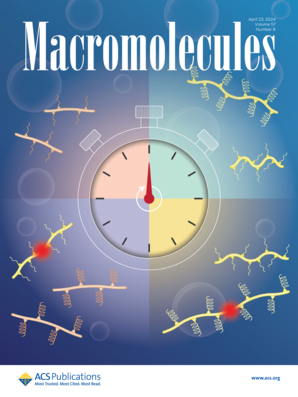Crystallization Rate Minima of Aliphatic Polyesters Type PE-X,Y in a Wide Range of Undercooling: Role of CH2 Sequence Length and Layered Crystallites
IF 5.1
1区 化学
Q1 POLYMER SCIENCE
引用次数: 0
Abstract
Herein, we use three series of aliphatic polyesters, designated as PE-X,Y─where X and Y denote the number of carbon atoms in the diol and diacid, respectively─as model systems to ascertain the molecular and structural factors that govern the manifestation of minima in the temperature dependence of the isothermal crystallization rate. We demonstrate that a required structural factor to observe rate minima is the formation of layered crystallites (lamellar crystals with ester-layered crystalline regions). Up to X ≅ Y/2, polyesters of series PE-X,18 develop layered crystals, and many display up to three rate minima. Unlayered polyesters such as PE-10,18 do not show rate minima. Such correspondence supports the notion of frustration or “self-poisoning” to explain the retardation of the rate observed in a narrow range of temperatures at the transition between quantized crystal thicknesses, thus indicating that the layer is a marker to detect rate anomalies that may point out specifics of polymer crystal growth. The aliphatic CH2 length between esters is an additional factor limiting the manifestation of rate minima. Despite forming layered crystals with quantized crystal thicknesses, as documented by X-ray measurements, the lack of rate minima in the even-spaced polyesters PE-X,12 is explained as a fast thickening at the transition between quantized crystal thicknesses. Furthermore, we also point out that the rate minima observed at temperatures close to the glass transition occur at the convergence of bimodal crystallization kinetics that differs between heterogeneous (high temperature) and homogeneous (low temperature) nucleation modes. Polymorphism, which is observed in some polyesters with a short odd-spaced diol, is uncorrelated with the observed rate minima.

大范围过冷条件下PE-X,Y型脂肪族聚酯的最小结晶速率:CH2序列长度和层状结晶的作用
在这里,我们使用三个系列的脂肪族聚酯,分别命名为PE-X,Y(其中X和Y分别表示二醇和二酸中的碳原子数)作为模型体系,以确定控制等温结晶速率温度依赖性最小表现的分子和结构因素。我们证明了观察速率最小的一个必要结构因素是层状晶体的形成(具有酯层状晶体区域的层状晶体)。高达X × Y/2,系列PE-X,18的聚酯发展成层状晶体,许多显示高达三速率最小值。非层状聚酯如PE-10、pe - 18不显示最小速率。这种对应关系支持挫折或“自我中毒”的概念,以解释在量子化晶体厚度之间转变时在狭窄的温度范围内观察到的速率延迟,从而表明该层是检测速率异常的标记,可以指出聚合物晶体生长的具体情况。酯之间的脂肪族CH2长度是限制最小速率表现的另一个因素。尽管形成了具有量子化晶体厚度的层状晶体,正如x射线测量所记录的那样,在均匀间隔的PE-X,12聚酯中缺乏速率最小值,这可以解释为在量子化晶体厚度之间的过渡中快速增厚。此外,我们还指出,在接近玻璃化转变的温度下观察到的速率最小值发生在非均相(高温)和均相(低温)成核模式之间不同的双峰结晶动力学收敛处。在一些具有短奇间距二醇的聚酯中观察到的多态性与所观察到的最小速率无关。
本文章由计算机程序翻译,如有差异,请以英文原文为准。
求助全文
约1分钟内获得全文
求助全文
来源期刊

Macromolecules
工程技术-高分子科学
CiteScore
9.30
自引率
16.40%
发文量
942
审稿时长
2 months
期刊介绍:
Macromolecules publishes original, fundamental, and impactful research on all aspects of polymer science. Topics of interest include synthesis (e.g., controlled polymerizations, polymerization catalysis, post polymerization modification, new monomer structures and polymer architectures, and polymerization mechanisms/kinetics analysis); phase behavior, thermodynamics, dynamic, and ordering/disordering phenomena (e.g., self-assembly, gelation, crystallization, solution/melt/solid-state characteristics); structure and properties (e.g., mechanical and rheological properties, surface/interfacial characteristics, electronic and transport properties); new state of the art characterization (e.g., spectroscopy, scattering, microscopy, rheology), simulation (e.g., Monte Carlo, molecular dynamics, multi-scale/coarse-grained modeling), and theoretical methods. Renewable/sustainable polymers, polymer networks, responsive polymers, electro-, magneto- and opto-active macromolecules, inorganic polymers, charge-transporting polymers (ion-containing, semiconducting, and conducting), nanostructured polymers, and polymer composites are also of interest. Typical papers published in Macromolecules showcase important and innovative concepts, experimental methods/observations, and theoretical/computational approaches that demonstrate a fundamental advance in the understanding of polymers.
 求助内容:
求助内容: 应助结果提醒方式:
应助结果提醒方式:


